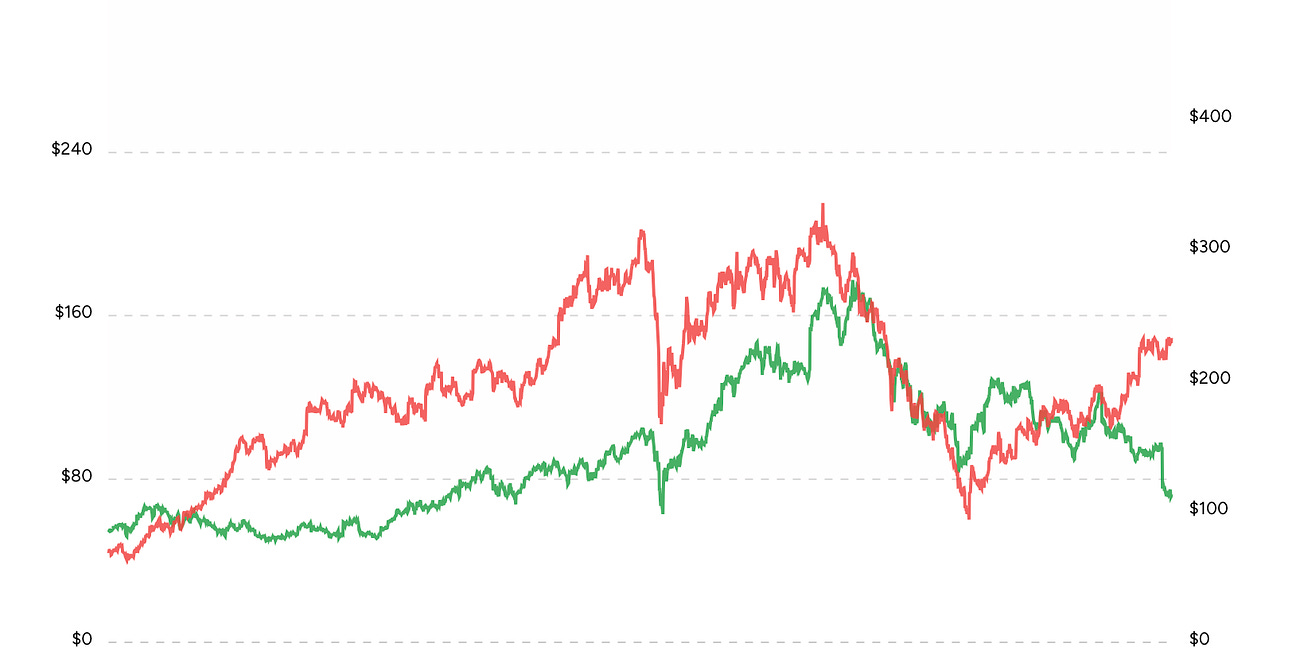March Long/Short Strategy – Back to Shoes
Revisiting Nike vs. Adidas: A Strategic Play on Footwear Giants
Hello Gold Subscribers,
For the March Gold Strategy, we’re revisiting one of our past Pair Trading Strategies—Nike vs. Adidas.
Nike and Adidas are two of the biggest names in the global sportswear industry, competing across footwear and apparel markets. While Nike dominates the U.S. with its strong brand loyalty and innovation in performance footwear, Adidas has a significant presence in Europe and has made strides in lifestyle and sustainability-focused products.
The article below features our previous long/short strategy, originally shared in July 2024.
Strategic Opportunities: Evaluating Nike and Adidas L/S Amidst Changing LTIP Dynamics
Hello fellow gold subscribers!
Below is the 10-year performance of a portfolio that started with a $1,000 long position in Nike and a $1,000 short position in Adidas. The relationship has remained strong, though the cycles take time to play out. Given the significant appreciation of the EUR over the past month, we believe this is another opportune moment to re-enter the long/short trade.
Nike maintains a stronger liquidity position than Adidas, with cash reserves covering 86% of its total debt, compared to Adidas, where cash covers only 44%. However, Nike is also more leveraged in absolute terms, carrying $12.06 billion in debt versus Adidas’s €5.81 billion (~$6.4 billion USD).
While our previous article outlines why this long/short strategy makes sense, we’d like to emphasize that there are also some less conventional factors at play.
For instance, Nike's executive compensation structure, particularly its use of stock options and Performance-Based Stock Units (PSUs), may present a potential avenue for "sandbagging" guidance to maximize stock-based compensation. Nike grants stock options to executives at the market price on the date of grant, meaning options only provide value if the stock price appreciates. These options vest over four years, which aligns executives with shareholders in the long term but also creates an incentive to depress stock prices before grants. Additionally, 50% of Nike’s long-term compensation is tied to PSUs, with payouts based on Relative Total Shareholder Return (TSR), but capped if Absolute TSR is negative. This structure could lead executives to issue conservative guidance or underperform in the near term, thereby lowering the performance bar for future years and setting up easier benchmarks for outperformance.
Furthermore, Nike’s adjustment of its stock grant timing from August 1 to September 1 for fiscal 2025 and beyond raises further concerns about potential sandbagging. By managing expectations downward ahead of the grant period, executives could ensure a lower starting stock price for new options and PSUs. Nike’s fiscal 2024 PSP payout of 65%, significantly below target due to underperformance in revenue and EBIT, could also point to a strategy where executives intentionally set a conservative outlook to position themselves for future upside.
At the time of this writing NKE 0.00%↑ trades at 67,07$ while Adidas is trading at 223.1 € at a current exchange rate EUR.USD of 1.0799. In terms of Implied Volatility Nike is at 25% while Adidas is at 31%.
We believe this allocation should be adjusted to IV in terms of current allocation. So for each 1.24 Dollar in NKE 0.00%↑ there should be a short of 1 Dollar in Adidas or ~0.9267€.







